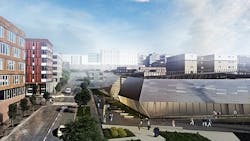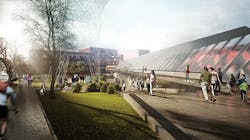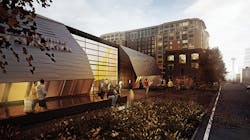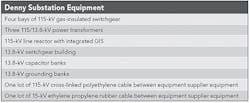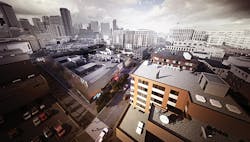Seattle Unveils NexGen Substation
Many cities hide their urban electrical substations behind buildings that are works of art. However, few offer their communities the destination activities that will become a part of Seattle City Light’s planned Denny Substation in Seattle, Washington, U.S. Some artistically designed urban substations include the dynamically formed Buzzard Point Substation proposed in Washington, D.C., the Mondrian-inspired abstract City North Substation in Sydney, Australia, and the seamless black basalt substation in Innsbruck, Austria. These are pleasing, artsy boxes designed to hide the industrial guts of the substation. They present pretty faces to passersby. But those designs do not invite people to the site and offer them fun things to do. The Denny Substation design does.
A Focal Point
When the Denny Substation is energized in the spring of 2018, it is expected to become a focal point for surrounding neighborhoods. Seattle architecture firm NBBJ designed the substation to include an off-leash dog park and a 0.25-mile (0.4-km) interpretative walking loop elevated by gentle slopes that will provide unique views of Denny Way and the cityscape.
The utility has partnered with the Seattle Office of Arts and Culture to integrate both permanent and temporary art into the substation. The City of Seattle designates 1% of capital budgets for art. Permanent art will include a sculpture called “Transforest” that blends the natural beauty of the region with the history of power generation and transmission. Built into two corners of the substation will be a series of switches called “Switchwall” that move with the wind and turn colored lights on and off.
Tucked into one side of the site will be an urban food court for food trucks and food carts to serve their fare during neighborhood events. The design also includes a learning center where residents can find out more about Seattle City Light, the Emerald City’s publicly owned utility, and how it promotes the use of renewable energy sources such as hydroelectric power, wind power and other sustainability efforts.
The substation building design continues the celebration of the location and will be a visual delight for the neighborhood. The building’s metal-clad walls are designed to slope inward toward the substation. This will make the building look less imposing to pedestrians and create a friendlier urban face. Translucent glass panels will emit a soft glow at night.
However, behind Denny Substation’s pretty face are some tough urban and engineering design challenges. The design proposals had to make their way through the demanding political process known as the Seattle Way, which values popular participation, debate and a high level of public benefit from such projects.
Powering Growth
Seattle City Light started on the path to building a new substation in 2012 to serve future growth in the area north of downtown, from Denny Triangle to South Lake Union. At that point, the utility’s planners thought they had plenty of time to design and build a new substation. However, six months after the Seattle City Council gave the utility the go-ahead for full design, the economic development dam burst. Companies’ plans for new high-density residential and commercial space started becoming a reality at a pace that had not been expected.
Some of the best-known names in business are building high-rise office towers in the neighborhood. Amazon, the world’s largest online retailer, is building a new corporate headquarters that will include three 38-story office towers, two mid-rise office buildings and a meeting center, all built on three city blocks. Vulcan, the company started by Microsoft cofounders Paul Allen and Jody Allen, is putting up the Block 45 Project, a 12-story building in South Lake Union.
Other nearby construction includes the Pacific Northwest’s largest hotel, a 45-story project in the Denny Triangle area. A new 36-story office and apartment tower is planned for just three blocks from the new Amazon headquarters. In all, more than a dozen major projects have been announced or are under way. The electrical load density for this area is about to increase dramatically as more people and businesses come into the area.
Adding more urgency to City Light’s plans is the fact that the nearby aged Broad Street Substation has nearly reached its load limits. Moreover, construction of the Alaskan Way Viaduct replacement tunnel requires part of the Broad Street Substation distribution feeder system to be de-energized for a time.
Technical and Design Puzzles
Seattle City Light selected 1250 Denny Way, the site of a former Greyhound Bus maintenance facility, as the location for its new substation. The 120,000-sq ft (11,150-sq m) area offered several advantages:
•It was close to electrical load centers.
•It had an underground high-pressure, fluid-filled (HPFF) 115-kV line running through the site.
• It had enough area for a substation.
•It offered the ability to disperse feeder lines in every direction.
Still, the site presented some demanding technical and design puzzles. A lot of equipment and functions would have to go into a relatively limited space that did not allow for an open-air insulation substation. The diverse project team tackling those issues included POWER Engineers, serving as the project manager and overseeing electrical design, and KPFF Consulting Engineers, serving as the structural and civil engineer.
The Denny Substation and its network distribution system have to be highly reliable. They are critically important to economic growth in the South Lake Union and Denny Triangle neighborhoods. Achieving the needed reliability in the available space posed numerous design difficulties. Addressing these issues was often at odds with the public amenities portion of the design, as both processes moved in parallel.
In some 15-kV fault scenarios such as bus faults or breaker failure, there had to be a way to avoid loop flow. All of the transformers’ secondary winding had to be connected in parallel, requiring all of the tap changers to be in the same position. One problem with connecting the network distribution transformers’ secondary winding in parallel is it causes extremely high fault currents. These high fault currents can push the capability for breaker interruption and could exceed the capability of downstream 13.8-kV feeder equipment, rated at 25 kA.
The project team studied several potential solutions such as increasing transformer impedance, adding inductors and other solutions. Each possible fix either required equipment that would not fit in the substation’s compact space or would not meet performance demands. In the end, the project team decided to write a performance specification for all the substation high-voltage equipment and allow some really talented people at the original equipment manufacturers (OEMs) to propose solutions. This approach allowed the project to capture available technical solutions as well as competitive pricing proposals.
Seattle City Light received four different proposals from OEMs that offered unique approaches to the performance requirements. The utility chose a solution that split the work between Mitsubishi Electric Power Products Inc. and ABB Group. ABB proposed using higher-impedance transformers and its Is-limiter, a fast-acting switching device, in the ring bus. This resulted in additional switchgear cubicles but solved the high fault current issue. Mitsubishi will provide the 115-kV gas-insulated switchgear while ABB will provide the transformers and 13.8-kV equipment.
An existing 115-kV HPFF line runs through the Denny Substation site. This transmission line, which will be above-grade during most of construction, will be bisected to provide separate lines from the Denny Substation to the East Pine Substation and Broad Street Substation. The HPFF transmission line is proposed to operate at 115 kV with the potential for the East Pine connection to operate at 230 kV in the future. The change to 230 kV is necessary as the electrical demand increases and more areas of north of downtown Seattle are switched to a network distribution system.
Around 2019, a new high-voltage transmission line will connect Denny Substation to the existing Massachusetts Substation in the south of downtown neighborhood, or SoDo as the area just south of Pioneer Square and the Chinatown-International District is called. Denny Substation and the associated transmission circuits will also serve as backup in case of outages or loss of equipment at nearby substations. Receiving the equipment outline drawings and finalizing the 13.8-kV bus design for the Denny Substation allowed the final layout of the yard and detail design to move ahead.
Project Attention
Nearby South Lake Union neighbors of the Denny Substation project include an upscale retirement community and the Seattle Cancer Care Center. Along with providing power for all the new construction underway, the substation also will support the University of Washington School of Medicine’s biotechnology and medical research hub, the Fred Hutchinson Cancer Research Center, the Seattle Cancer Care Alliance, the Bill & Melinda Gates Foundation and PATH, an international health organization.
The people of Seattle generally are well-educated and highly involved in the community. Naturally, the Denny Substation attracted a lot of attention. Early public concern focused on what the substation would look like, with the fear it meant a bunch of open-air electrical equipment surrounded by a chain-link fence or brick wall. Other questions arose about electromagnetic field and noise. But Seattle City Light committed early to provide something different from the usual substation.
Approvals for the project involved numerous elected officials and a multitude of city departments. The utility and its project team dealt primarily with 20 interested parties but more than 70 were involved at one point or another. The team had extensive meetings with the Seattle Design Commission, which is made up of professionals in architecture, planning, engineering and urban design who advise the city on the design of capital improvement projects.
Because the final design called for vacating Pontius Avenue North between Denny Way and John Street, the utility needed to provide offsetting public benefits. This is the reason for the off-leash dog park, interpretative walking loop and many other amenities.
The city also requires elements of sustainability on such capital improvement projects. The substation site will include native and drought-tolerant plants, installation of solar array panels, light-colored walking surfaces to reduce heat, easy access to mass transit, bicycle stands and other features. Additionally, the utility performed an extensive environmental cleanup at the site, digging 40 ft (12 m) down from the surface to remove soil contaminated by diesel fuel from the old Greyhound Bus maintenance facility.
To keep the public well-informed, Seattle City Light and the project team created a website to post updates, provided a phone hotline for messages, emailed interested contacts, and created Facebook and Twitter pages about the project. Numerous public meetings also were held to ensure an open line of communication between the utility and the public. This effort sustained an engaged public constituency that will be continued throughout the construction phase of the project.
Meeting the Challenge
In August 2015, the Seattle City Council gave final approval for Seattle City Light’s first major substation project in 30 years. Getting to that point required a lot of coordination and cooperation among elected officials, public agencies, design teams and many others, as well as input from citizens. Moving the project through this process proved to be the real challenge. Successfully meeting that challenge enables the utility to achieve its mission of service to customers and gives Seattle a substation design that celebrates its place in the Emerald City.
Michael Clark is the substation program manager for Seattle City Light and a project management professional with more than 25 years of experience managing and coordinating municipal infrastructure and urban development projects. His strength and expertise in supporting complex project implementation in high-density urban centers is a focused and comprehensive approach in aligning strategic business and operations planning, policy development, project management, conceptual and technical design, operational and workload planning.
Joe Orth is a principal engineer in the substation engineering group of Seattle City Light with more than 20 years of experience designing and constructing major utility infrastructure projects in both the generation and transmission and distribution arenas. His expertise includes innovative ways to solve the many problems major utility projects face and to move these projects through the design process to successful completion. He is the technical lead for the Denny Substation Project, a registered professional engineer, and he holds an MSEE degree from the Georgia Institute of Technology.
Jay Keeling is a professional electrical engineer and veteran POWER project manager who specializes in management and design supervision for large utility substation and transmission facility projects. His background is particularly strong in advanced, sophisticated substation engineering, including projects of high and extra high voltage, and large compensation installations. He has particular expertise in complex, nontraditional station designs, including series compensation, static var compensator (SVC), static synchronous compensator (STATCOM) and gas-insulated switchgear (GIS).
